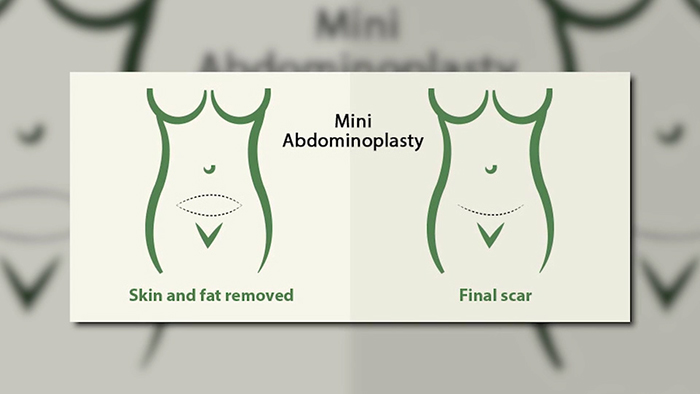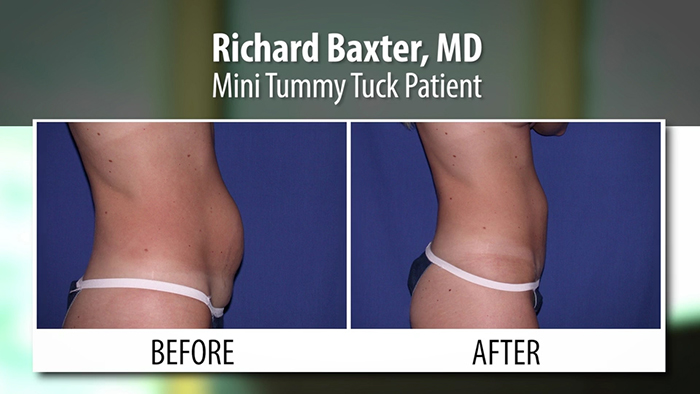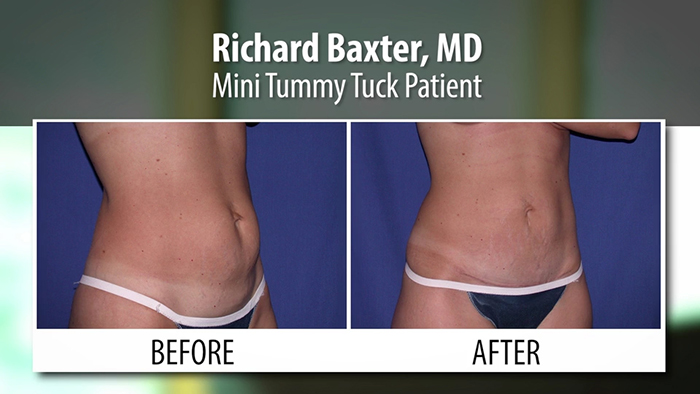Some women have several children and are able to diet and exercise down to their pre-baby jeans. We call those women…winners of the genetic lottery. For the rest of us, a bulging tummy and extra skin are constant reminders of our bundles of joy. The tummy tuck, also known as abdominoplasty, was the 3rd most popular aesthetic surgical procedure in 2015 according to the American Society of Aesthetic Plastic Surgeons. Dr. Richard Baxter, a board certified plastic surgeon based in Seattle, Washington offers several variations of an abdominoplasty for his patients. “The first question a prospective tummy tuck patient will ask in consultation is, “Do I really need a full tummy tuck, or can I get by with a mini? About 85% really do need a full tummy tuck, but for those in the other 15% we can do a mini with a special adjunct procedure that maximizes the mini.” It’s called, “the umbi float.”
by Isabel Bolt
and Richard Baxter, MD
Maxi or Mini…and What Lies Beneath?
The short answer is: your body will choose for you. According to Baxter, the proper diagnosis is key. Some patients may need only skin removed and muscles tightened on the lower abdomen—a partial or modified abdominoplasty. Others may only need muscle tightening and liposuction —a standard mini abdominoplasty. A complete abdominoplasty addresses the loose skin and lax muscle of both the upper and lower abdomen. In every case the desired result is tighter skin, a flatter, firmer abdomen, and a contoured waist.
If the skin has stretch marks, liposuction alone may not be a good idea because the skin will not contract after the procedure. If there is only excess thickness of the fat layer under the skin, then liposuction alone may suffice but this is rarely the case. Keep in mind, liposuction treats fat. It does not eliminate excess skin.
Most people are surprised to learn that pregnancy is not simply weight gain with excess fat–the skin has stretched and the muscle beneath is often separated, particularly after multiple pregnancies. Many mistake extra skin and a bulging belly as “fat” when in fact it is the result of skin and the underlying fascia having been hyperextended, and muscles that have separated beneath. A majority of women experience diastasis recti, separation of the rectus (sit-up) muscles after pregnancy. No amount of sit-ups will reposition the muscles. A quick exam during your consultation will reveal whether there is indeed muscle separation. It is best to repair this in conjunction with a tummy tuck because it will really flatten the abdomen–think of it as an internal girdle. Without this surgery, the abdomen will appear curved and bulged regardless of exercise or weight loss.
The Umbi-float
Baxter recommends a mini tummy tuck with an “umbi float” for a relatively small patient population where there is muscle separation, but excess skin is confined to the lower abdomen. “A mini tummy tuck will not tighten the skin above the belly button,” explains Baxter. “With a typical mini, we would address the lower abdomen skin only. We wouldn’t be able to get high enough in the abdomen to repair the muscle. The umbilical float technique allows us to do both.” He explains the surgical procedure is still a mini, but by dissecting and detaching the belly button from underneath he can get into the upper abdomen, tighten the muscle layer all the way down and reattach the umbilicus, or belly button. “There is never a scar on the outside and the muscle repair flattens the upper belly from the inside, out, improving the whole abdominal contour.”
Variations on a Theme
There are up to 7 variations of abdominoplasty that Dr. Baxter offers his patients. All are customized to the patient’s needs. As discussed, the mini tummy tuck or mini with umbi float are options for those with only lower ab excess skin. “The most common is a full tummy tuck where skin is removed from the lower abdomen and upper ab skin is ‘pulled down’ to expand and cover where skin was removed. In addition to skin removal and tightening, muscle separation is repaired and localized fat is treated with liposuction.” A tummy tuck with a T-closure is used when the skin is not lax enough to remove all the way up to the belly button while still keeping the scar low.
Massive weight loss patients often differ from those seeking to proportion their post-pregnancy body. Using a variation on the T-closure called the Fleur de Lis, Dr. Baxter pulls more skin in from the sides, and top to bottom. An extended tummy tuck is another option for patients with substantial weight loss where the scar is longer to remove and tighten more skin on the sides. Finally, a reverse tummy tuck flips the scar from the bikini line to under the breasts. Dr. Baxter explains. “Think of it as a mini tummy tuck because it has no effect on the lower ab. The scar is under the crease of the breasts, so it is a great option when a breast lift or revision surgery is planned. You get the benefit of two procedures with one scar.”
Are you a Candidate?
While most women’s bodies don’t snap back to pre-pregnancy proportions, many find committing to a proven diet and exercise program will help with tone, definition, and weight control. Although exercise will help strengthen the muscles stretched open during pregnancy, it cannot replace the effectiveness of surgery for the correction of damaged, loose skin, and muscle separation. It depends upon your body and how strongly you feel about surgical intervention for a post pregnancy “bulge”. Dr. Baxter advises patients to be very close to their ideal body weight before seeking body reshaping surgery as this insures the best possible result. If you are considering future pregnancies, it is a good idea to wait for this procedure until your family is complete.

















Facebook
Twitter
Instagram
YouTube
RSS